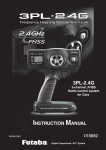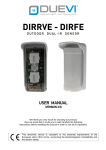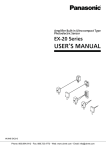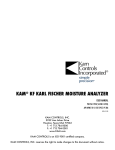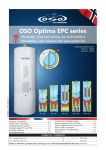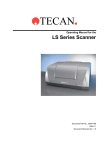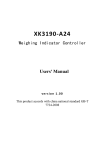Download TGC-2
Transcript
TGC-2 Preventative Maintenance Guide Tendring Pacific – Technical Support Telephone. 01223 492080 Email. [email protected] 1 7TH March 2013 Revision 1 Safety Instructions Personnel operating and maintaining the device must be familiar with all aspects of its operation and be proficient in maintenance. Such Personnel should review the following precautions to promote safety awareness. General • • • • Always refer to the manual before operating or maintaining the equipment. Observe all WARNINGS, CAUTIONS and NOTES. Do not open the device. In case of technical problems please contact Tendring Pacific. Do not cover the machine with a cloth or piece of plastic to protect it from dust, as this prevents free air circulation around the machine and might lead to overheating and errors in the sensor read‐out. • Do not expose the equipment to heavy moisture or heat and keep it away from direct sunlight. • Never short circuit or remove safety devices. Installation • • • • • • • • To ensure the best installation with the least technical problems, please install equipment as described in the manual. Never install the equipment in explosive environments. Always use correct fittings when connecting gas from the gas bottle. Provide adequate space around the equipment for proper ventilation. The units are Class 1 appliances and must be connected to an earthed mains connection. It is the responsibility of the owner and operator(s) of the equipment, that the installation is made in accordance with local rules and regulations. When installing the equipment it is necessary to ensure proper ventilation in the room of the installation in accordance with requirements from manufacturer. The Manufacturer cannot be held responsible for any damage caused by incorrect installation of this equipment. Operation and Maintenance • Be sure to disconnect electrical power and unplug the unit before performing any cleaning or maintenance. • All panels and protective guards must be in place before operating the equipment. • When operating or maintaining the equipment always obey the relevant rules and regulations for workers safety. • Repair or replace damaged power cords immediately. • Never block gas outlets. 2 7TH March 2013 Revision 1 Cleaning and Maintenance General Caution ! Personnel performing any maintenance or cleaning must familiarize themselves with the “Safety Instructions” before attempting any of these procedures. Cleaning All of the device’s surfaces must only be cleaned using a mild soap solution and a soft wrung cloth. Caution ! Never use hard tools or abrasive materials when cleaning any part of the device. Warning ! Never use cleaning agents containing any kind of acid. These constitute a health hazard and could damage the instrument. 3 7TH March 2013 Revision 1 TGC‐2 Maintenance In addition to Annual Service & Calibration it is recommended to carry out the following Maintenance checks at the interval times stated below. Once a Week: Measuring gas lance filter (see instruction no.1) Check and replace once a week for before if dirty Measuring gas lance thumbscrew (see instruction no.2) Check the thumb screw is tight. Spot test needle (see instruction no.3) Check and replace once a week or before if required. Spot test water trap (see instruction no.4) Check and replace once or week or before if required. Once a Months: Fan Filter (see instruction no.5) Check and replace once a month or before if dirty. 4 7TH March 2013 Revision 1 Instruction no. 1 ‐ Measuring Gas input – gas probe Measuring gas lance filter ‐ check/replace by removing the yellow filter (part no. 210669 ‐ no.6 on diagram below) from the lance. Replace with a new filter and make sure the filter is tightly fitted or this can cause a leak. The gas probe consists of a 3.5 meter long hose with quick‐connectors at both ends. The lance end features a filter which is very easy to replace. Connect the quick‐connector (A) furthest away from the filter to the TGC‐2 measuring gas input (B) Connect either a connector with 2‐m hose or a connector to the sample gas lance to the quick‐connector at the other end. This hose/sample gas lance may be shortened, as required. Instruction no.2 – Measuring gas lance thumb screw Check the black thumb screw (no.9 on diagram below) is tight as this can cause a leak in the sample hose. Type 1 5 7TH March 2013 Revision 1 Diagram parts list 1. 2. 3. 4. 5. 6. 7. 8. 9. 10. 11. Quick connector socket Screw‐joint Hose, PE 5/3 nature Coupling Fitting, Filter Filter, measuring gas 1µ water trap Fitting, filter gas out O‐ring NBR 70 1,07x1,27mm Thumb screw, hose unload Hose, 1/16”x1mm + hose, PE 5/3 nature Fitting nipple 5x5 Part no. 980065 2pc Part no. 890360 4pc Part no. 980043 0.1pc Part no. 930774 2pc Part no. 930773 Part no. 930673 Part no. 970228 Part no. 910171 2pc Part no. 940080 2pc Part no. 920008 3.6m Part no. 980043 3.5m Part no. 890409 Instruction no. 3 – Replacing the Spot Test Needle Replace the spot test needle C (part no. 910611 ‐ see diagram below) by removing it from the water trap filter. Replace with a new needle and make sure it’s tightly fitted as this can cause a leak. Instruction no. 4 – Replacing the Spot Tester Water Trap Filter Replace the spot test water trap filter E (part no. 980022 ‐ see diagram below) by removing the needle C (see diagram below) and needle pen F (see diagram below) from the water trap filter. Replace with a new filter and make sure it’s tightly fitted as this can cause a leak. 6 7TH March 2013 Revision 1 Assembly of needle for spot measuring. Diagram Parts List 1. 2. 3. 4. 5. 6. 7. Needle 0.8mm Needle filter 5µ Water trap (filter 0.2µ) Needle pen O‐rings Finger screws Measuring gas hose Part no. 910611 Part no. 970178 Part no. 980022 Part no. 970169 Part no. 910171 Part no. 900348 Part no. 890407 Note. The measuring gas hose must be taken right through the needle pen F (see above diagram) and stop right before the filter in water trap E (see above diagram) 7 7TH March 2013 Revision 1 Instruction no. 5 – Replacing the Fan Filter Visually check and replace filter (part no. 910648) if dirty. TGC‐2 Consumable Parts:‐ Filter, cooling 60x60 (10pcs) Filter, sample gas 0.2µ, water trap Filter, water trap 0.2µ, (3pcs) Filter, needle 5µ (10pcs) Needle kit, Ø0.8mm (10pcs) Septums Ø15mm (100pcs) Septums Ø15mm (1000pcs) Septum, kit 10 pcs + instructions grey/soft Part no. 210648 Part no. 980022 Part no. 200067 Part no. 220079 Part no. 220078 Part no. 940296 Part no. 940301 Part no. 940436 8 7TH March 2013 Revision 1 FAULTS / REMEDY There are 5 different types of fault messages: 1. Error found during self‐test. Displayed during start‐up of TGC‐2. 2. Operating fault. Displayed in case of incorrect entry/selection. 3. Info message. Only shown in measuring screen I and measuring screen II concurrently with a flashing screen. 4. Fault. The ready‐relay is deactivated. This type of fault is only displayed in measuring screen I and measuring screen II concurrently with a flashing screen. 5. System error. The ready‐relay is deactivated. All functions in TGC‐2 are shut down. “Span too small” (2) The stated value is too close to another value, e.g. min. or max. values. This fault message appears if attempts are made to calibrate with a gas concentration already used for calibration. ”Can not clear last prod.” (2) There should min. be one product. The last product cannot be cleared. "Bad access code" (2) During change of access code a bad access code has been entered. "Calibr. with 20.9%O2 first" (2) After 20.9 %O2 offset adjustmentÇ has been performed, recalibration of the O2 sensor should always start with a calibration using 20.9%O2. Other gas concentrations may then be used for calibration. 9 7TH March 2013 Revision 1 "Not Ready" (2) 1. Print‐out already in progress. Wait until the on‐going print‐out is completed. 2. Printer/PC not connected or printer connected not switched on or not on‐ line. Check any cable connection(s). To interrupt printing, stop any data logging to printer (press ¤ µ to switch to (data logging to printer stopped). Next interrupt printing (¤ ¹) see"5.14.5. Interrupting on‐going print‐ out" in User Manual. 3. Calibration cannot be performed during the heating period. TGC‐2 should have beenswitched on for min. 4 consecutive hours before calibration may be performed. "Stop measuring” (2) Calibration cannot be performed if on‐line measuring is active (¥ is selected). Turn on‐line measuring off in the main menu by pressing ¤¤. "Data Logging" (2) Product setting for the active product cannot be changed when data logging has been selected and on‐line measuring started up. Or, printing cannot be started when TGC‐2 is logging to printer. To stop on‐line measuring press ¤ ¤. To stop data logging press ¤µ to switch to (data logging to printer stopped) and to switch to (data logging to buffer stopped). "Resetting log" (1) There is an internal fault in the data location for log data. All log data for all products will therefore have to be reset. Log data are checked during the self‐ test. "Printer/PC is not ready to receive data" (3) Printing has been started, but printer/PC is not ready to receive data. Check connection to printer/PC. Printing can be interrupted by pressing ¤ ª. If data logging to printer has been selected, this message will pop up again as soon as an attempt is made to print out new log data. In this event, stop logging to printer. 10 7TH March 2013 Revision 1 "Log memory capacity is now below 25" (3) There are less than 25 locations left for data logging. Print out, and clear any data logging from memory. If data logging memory is full, new data logging will not be saved in the memory. “External flow error” (4) Back pressure in the lance measuring hose is too high. Try to perform a flush back (¤´¡) and check/replace filter in measuring lance, if necessary. “External press. error” (4) Back pressure in the lance measuring hose is too low. Check hoses, filter and connections to the measuring lance (possibly pump error). “Internal flow error” (4) Back pressure in the internal flow system is too high. If this fault occurs during spot measuring, check the spot measuring hoses and replace needle and filter, if necessary. “Internal press. error” (4) Back pressure in the internal flow system is too low. If this fault occurs during spot measuring, check hoses, filter and connections to the needle. (possibly pump error). “Extern CO2 pressure is low. Check gas supply” (4) “Extern O2 pressure is low. Check gas supply” (4) “Extern N2 pressure is low. Check gas supply (4) The external gas input pressure for the specific gas has dropped below the permitted. Minimum permitted input pressure for each gas input is specified on a label on the rear of TGC‐2. Make sure the input pressure lies within the specified range both at no gas consumption/flow and at max. gas consumption/flow. "Test measuring" (3) Shown non‐flashing. TGC‐2 measures without any external measuring signal and all alarms are switched off. Press ¤ ´ to switch to (test measuring stopped). Normal on‐line measuring is now active again. 11 7TH March 2013 Revision 1 “Mixer error” (4) Cannot set electronic mixer. Power off TGC‐2 and power on again. In case of repetitive faults, contact Tendring Pacific authorised personnel. If this fault pops up, TGC‐2 cannot set the electronic mixer. For manual setting of mixer, remove cover on front and set the mixer. See “Setting up gas mixer" in the User Manual. “Manual flow dial is not closed" (3) Shown non‐flashing. This TGC‐2 features electronic flow regulation. The manual flow regulation dial under the cover on the front is not closed. This dial should only be used if a fault occurs where the electronic flow regulation does not function. “’Alarm off’ is selected on manual switch” (3) Shown non‐flashing All alarms are deactivated. The switch on the front is on position ‘Alarm off’. In normal operation this switch should be on position ‘Alarm auto’. See "Alarm auto./off switch" in User Manual. “Device temperature > 60°C” (5) Too high temperature inside the TGC‐2. Check the dust screen in front of the fan. Replace, if necessary and restart TGC‐2. In case of repetitive faults, contact Tendring Pacific authorised personnel. “Bad ROM checksum”, “I2C communication bus”, “AD7714”, “LFsignal is high”,“Thermocouple”, “CO2 sensor temperature”, “O2 sensor temperature” (5) Internal fault, power off TGC‐2 and power on. In case of repetitive faults, contact Tendring Pacific authorised personnel. «icon missing If the "Spot measuring time" parameter is set to 0 seconds, the « icon is removed from measuring screens I and II. See "Setting of spot measuring time and Measure delay" in User Manual. If the error number/message persists , take a note of these and contact Tendring Pacific. 12 7TH March 2013 Revision 1 For any further information or to book an Annual Service & Calibration of your TGC‐2 please contact Tendring Pacific Technical Support. Contact details: T: 01223 492080 E: [email protected] 13 7TH March 2013 Revision 1













